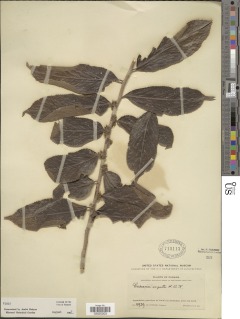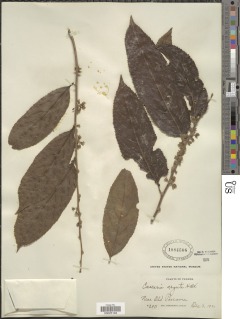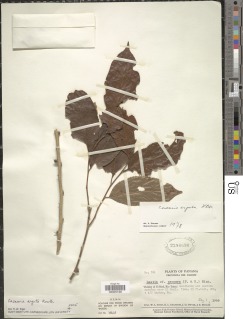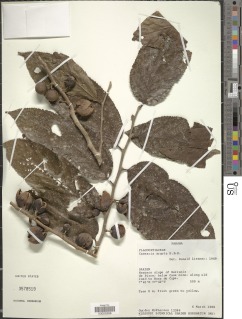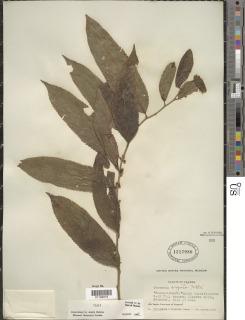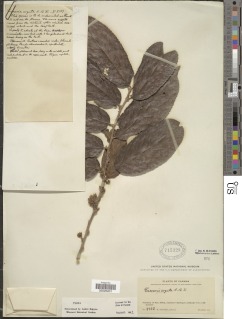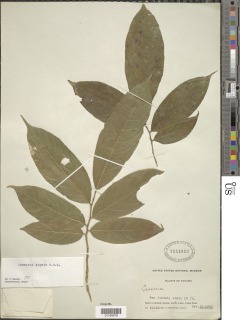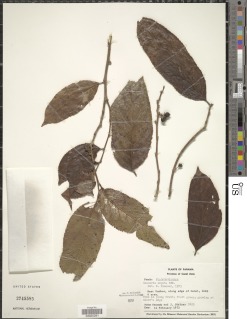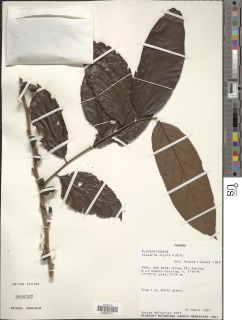

|
|
|
|
Family: Flacourtiaceae
Corta lengua, more...pica lengua
|
Description: A shrub or treelet, no more than 6 m tall. Leaves are toothed, simple, alternate, and arranged in a flat plane, regularly-spaced along the branches, long, parallel-sided; undersides have bluish tint from tiny hairs. Branches can be long, with many leaves. Reproduction: Flowers are produced in December, in dense clusters packed tightly along the branches; they are white, about 1 cm across, strongly fragrant like honey. Fruits are green capsules with three valves. Distribution: Found most often in secondary forests of the Pacific slope, where it can be fairly common. Very common along roads in Gamboa. Rare in the forest. Similar Species: Toothed alternate leaves in a regular, flat plane, are characteristic of several species in the family Flacourtiaceae. Most also have transparent dots in the leaves, but these can be hard to see. LK casegu Casearia guianensis LK2 is most like C. arguta, but has leaf undersides without the bluish tint. See also LK zuelgu Zuelania guidonia, LK2 LK caseco Casearia commersoniana LK2 and LK casear Casearia arborea. LK2 A common shrub with toothed leaves and white stipules is LK hybapr Hybanthus prunifolius, LK2 but its leaves are smaller and arranged differently. Descripción: Árbol o arbolito de 3 a 10 m de alto. Hojas simples y alternas, de 5-18 x 2-7 cm, oblongas a oblanceoladas, con ápice acuminado, bordes aserrados o dentados y base redondeada o ligeramente asimétrica. Las hojas presentan puntos y rayas translúcidas y secan de color negro. Estípulas deciduas. Pecíolo de 0.2-0.5 cm de largo. Flores blancas y aromáticas, o a veces con un olor desagradable, agrupadas en fascículos axilares. Frutos en cápsulas globosas, de 0.8-2.5 cm de largo, verdes, tornándose amarillos y dehiscentes al madurar. Semillas con arilo amarillo, rosado o rojizo. Datos Ecológicos: La especie crece a bajas y medianas elevaciones, en bosques húmedos o muy húmedos. En Panamá se encuentra en las provincias de Bocas del Toro, Chiriquí, Coclé, Darién, Herrera, Panamá y Veraguas. Común y fácil de observar en márgenes de bosques de los alrededores del pueblo de Gamboa. Florece y fructifica de diciembre a octubre. Especies Parecidas: A menudo se confunde con LK casec2 Casearia corymbosa LK2 , pero en C. corymbosa los frutos maduros son anaranjados, rojos, o en muy pocas ocasiones amarillos. Usos: El tronco se utiliza para postes de cercas y leña. También en construcciones rurales y en la fabricación de mangos para herramientas. Los frutos maduros son comestibles y de sabor dulce. Shrub or small tree, 2-10 (12) m tall; trunk to 12 cm diam; branchlets often densely ferruginous-pubescent, becoming glabrous and lenticellate. Leaves deciduous; petioles usually less than 5 mm long; blades +/- oblong-elliptic, acuminate, +/- acute at base, 9-17 cm long, 2.5-6 cm wide, usually pellucid-punctate, pubescent on veins on both surfaces (especially below), the margins coarsely serrate with gland-tipped teeth. Fascicles dense., sessile, axillary, ca 2 cm broad; pedicels somewhat shorter than flowers, articulated near base; flowers greenish-white, with a moderately sweet aroma., 4-5 mm long; calyx 5-lobed, united near base, spreading at anthesis; corolla lacking; stamens usually 10, stiffly erect, alternating with very pubescent staminodia, the 5 alternating with calyx lobes somewhat shorter than the others; anthers with apical bristles; style held above anthers in bud; stigma round, minutely bristled, the surface with an abundant sticky fluid; ovary conspicuously pubescent, the pubescence merging with that of staminodia. Capsules +/- globose, to 2.5 cm diam, yellow at maturity, nearly glabrous; seeds numerous, irregular, to 8 mm long, embedded in a sweet, juicy, orange matrix. Common in the Canal Zone and to be expected on the island, but not seen in recent years. It was reported by Standley for the island, but no collections have been found. Flowers in the late rainy and early dry seasons; according to Allen (1956). It flowers several times at short intervals. The fruits mature in the late dry and early rainy seasons. Plants lose their leaves in the late dry season, while still bearing fruit, and remain leafless for a short time. |










